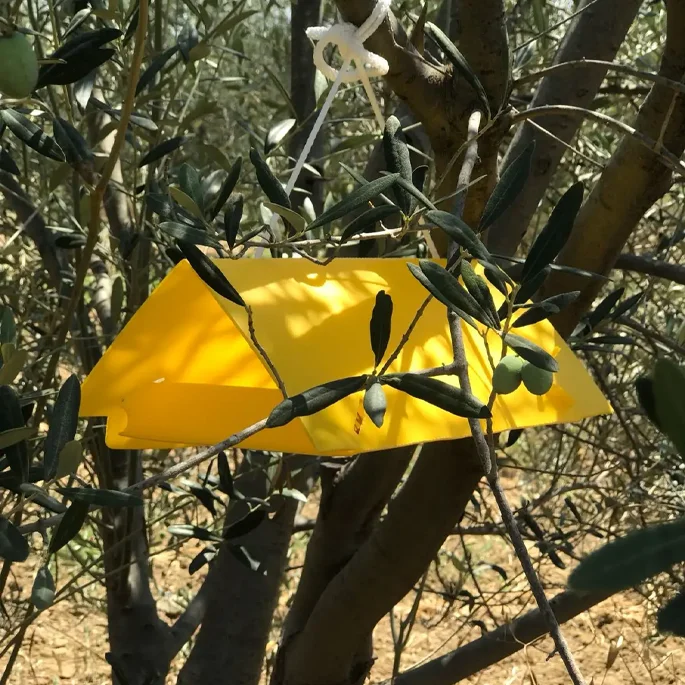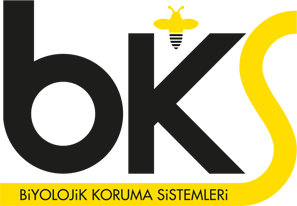YELLOW TRAP

Where is the Yellow Sticky Trap Used?
Yellow sticky traps are a type of trap often used to trap harmful insects. These traps are cards or strips of different sizes that have a sticky surface. It contains a special bait or a scented substance.
Yellow sticky traps are used to control many different types of insects in homes, workplaces and agricultural areas. For example, they can be used in homes to catch pests such as mosquitoes, ants, moths and cockroaches.
They are also used in gardens and agricultural fields to control whiteflies, aphids, spiders and other harmful insects. They are used on a particularly large scale in agriculture because they can help to significantly reduce the use of chemical pesticides.
The use of yellow sticky traps is an environmentally friendly method by reducing the use of chemical pesticides. However, it is important to place and use traps correctly. It is also important to remember that the traps must be used and replaced correctly, otherwise the traps may become ineffective.
How to use the yellow sticky trap?
Yellow sticky traps are a common method of insect control used in homes, gardens and farmland. Here are step-by-step instructions for using the yellow sticky traps correctly:
Choosing the right trap: You should choose the yellow sticky traps according to the type of insect you want to catch. You can research which traps the insects are most responsive to and what bait or scent to use.
Placement of traps: Place traps where insects frequent or are found. For example, they can be placed near windows where mosquitoes enter in homes, under plants in gardens, or among plants in agricultural areas.
Activating Traps: Traps are usually activated by a bait or scented substance. Place this bait or scented substance on or near the traps. For example, pheromones can be used in agricultural areas, fruit pieces or sugar water can be used in homes.
Checking the traps: You should check the traps regularly. Replace the traps if the sticky surface of the traps becomes dirty or insects escape from the trap.
Throwing Traps: Be careful when throwing traps. If there are dead insects in the traps, do not throw the traps directly into the trash. Instead, wrap the traps in a plastic bag or newspaper and then throw them away.
Before using the yellow sticky traps, it is important to read the instructions on the product's label. Proper use of traps helps control insects and contributes to reducing the use of chemical pesticides.
What does the yellow sticky trap do?
Yellow sticky traps are a type of trap generally used to control insects. These traps are small pieces of cardboard with a sticky surface and contain a special bait or scented substance.
The main function of yellow sticky traps is to catch insects. Thanks to its sticky surface, insects cannot move by sticking to the trap and remain in the trap. This prevents insects from multiplying and harming plants or people.
Yellow sticky traps are used to control many different types of insects in homes, gardens and agricultural areas. For example, they can be used in homes to catch pests such as mosquitoes, ants, moths and cockroaches. In gardens, they are used to control whiteflies, aphids, spiders and other pests. They are also used on a large scale in agriculture because they can help to significantly reduce the use of chemical pesticides.
The use of yellow sticky traps is an environmentally friendly method by reducing the use of chemical pesticides. Also, regularly checking and replacing traps makes them more effective at controlling insects.
How to use color traps?
Color traps are a type of trap used to control insects. Color traps are prepared by applying a sticky substance on surfaces of a specific color. Color traps are an environmentally friendly method and can reduce the use of chemical pesticides. Here are step-by-step instructions for using color traps correctly:
- Choosing the right trap: For color traps to be effective, you should choose them according to the type of insect you want to catch. For example, yellow traps can be effective for whiteflies, mosquitoes, aphids, and spiders, while blue traps are more effective for thrips and aphids.
- Placement of traps: Place traps where insects frequent or are found. For example, they can be hung under the plants in gardens or 15 cm above the plants in agricultural areas.
- Activating the traps: You do not need to place a bait or scented substance on the traps. The color that attracts the attention of insects enables the traps to be activated.
- Checking the traps: You should check the traps regularly. If the sticky surface of the traps becomes dirty or the sticky part becomes filled with insects, replace the traps with new ones.
- Throwing Traps: Be careful when throwing traps. If there are dead insects in the traps, do not throw the traps directly into the trash. Instead, wrap the traps in a plastic bag or newspaper and then throw them away.
The use of color traps is an environmentally friendly method of controlling insects by reducing the use of chemical pesticides. Color traps can trap many types of insects and prevent insects from multiplying and harming plants or people. However, it is important that traps are used correctly and checked regularly.
How to make a cherry fly trap?
Biotechnical control is a method of control using natural enemies or environmental factors of harmful organisms to control harmful organisms. This method is an environmentally friendly and sustainable method and reduces the use of chemical drugs. Here are some of the biotechnical control methods:
- Predators and parasites: Predators and parasites are natural enemies of harmful organisms. This method provides pest control by finding the natural enemies of harmful organisms and increasing the number of natural enemies.
- Microorganisms: Microorganisms are effective in controlling harmful organisms using their environmental factors. For example, some bacteria, fungi, and viruses control harmful organisms by killing them or preventing them from multiplying.
- Pheromone traps: Pheromone traps are a type of trap used to disrupt the reproductive behavior of insects. The traps mimic insects' sexual pheromones and attract insects to the traps. This method reduces the number of harmful insects and reduces the use of chemical pesticides.
- Plant resistance: Some plant species have natural resistance mechanisms to combat harmful organisms. This method involves using resistant plants to combat pests.
- Agricultural culture: Agricultural culture is a method of struggle using environmental factors to control harmful organisms. This method provides control by increasing soil fertility, improving habitats of natural enemies, and inhibiting the reproduction of pests.
Biotechnical control is an environmentally friendly and sustainable method by reducing the use of chemical drugs. However, the effectiveness of these methods is ensured by correct application and regular control measures.
Yellow Sticky Traps And What Are Their Uses?
Yellow sticky traps are a fighting method for pest control. These traps capture insects that attract to their yellow color and sticky surfaces, thus reducing the number of pests. Yellow sticky traps are widely used in agricultural production, greenhouse cultivation, gardening and floriculture. Here are some of the uses of yellow sticky traps:
- Agricultural production: Yellow sticky traps are used in agricultural production, especially in greenhouses and orchards. Insects damage fruits during flowering and harvesting periods. Yellow sticky traps increase fruit quality and productivity by reducing the number of these pests.
- Greenhouse: In greenhouses, harmful insects can cause loss of quality and decrease in the market value of the products. Yellow sticky traps are effective in controlling harmful insects in greenhouses. These traps are placed on the plants in the greenhouse and on the windows, and they control the pests that enter the greenhouses.
- Gardening and floriculture: In gardens and floriculture, pests can inhibit the growth of plants and harm plant health. Yellow sticky traps reduce the number of these pests, protecting the growth and health of plants.
- Woodlands: Yellow sticky traps are also used to control harmful insects in woodland areas. These traps protect the health of forests by reducing the number of pests found in forests.
Yellow sticky traps are an environmentally friendly and sustainable method of struggle by reducing the use of chemical drugs. However, it is important to use these traps correctly, to place them properly and to have them checked regularly. Also, the use of traps is preferred when natural enemies are not effective at controlling pests.
